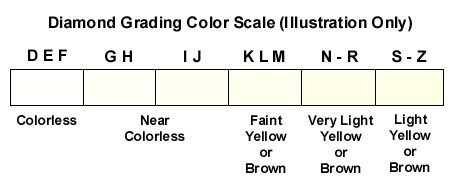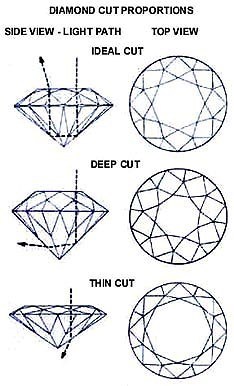The 4 Cs of a Diamond
No discussion about buying diamonds in any form is complete without discussing the classic "FOUR Cs" of: Clarity, Color, Cut, and Carat weight. Additionally, understanding diamond grading reports and the factors effecting a diamond’s cost (price) will also prove beneficial for increasing your confidence in knowing that you are making a sound decision.
- Clarity
Clarity measures the relative visibility of external blemishes or internal imperfections (inclusions) naturally occurring within a diamond as evaluated by a qualified gemologist. The clarity scale (GIA) is divided into six primary categories:
- Flawless (F or FL) — no discernible surface blemishes or inclusions visible when viewed at 10x magnification
- Nearly Flawless (IF) — insignificant surface blemishes and no internal defects visible at 10x magnification
- Very, Very Slightly included (VVS-1 & VVS-2) — extremely difficult to very difficult to find surface blemishes or minute inclusions at 10x magnification, but can be more readily seen at 10x once located at 20x magnification
- Very Slightly included (VS-1 & VS-2) — difficult to somewhat easy to find surface blemishes or minor inclusions at 10x magnification
- Slightly Included (SI-1 & SI-2) — easy to very easy to find surface blemishes or readily noticeable inclusions at 10x magnification, but will usually appear to be "eye clean" without magnification, though some stones will show slight inclusions when viewed from the side against a white background (note: GIA does not recognize an SI-3 clarity grade)
- Imperfect (I-1, I-2, I-3) — surface blemishes or obvious inclusions are somewhat difficult, easy, or very easy to find with the naked eye, especially after being located with 10x magnification; I-2 inclusions effect either the diamond’s aesthetic appearance (beauty) or durability (potential for cracking); I-3 inclusions effect both

- Color
The color scale is used to evaluate a diamond’s internal tint and plays a significant factor in determining its price, with colorless being the most desirable. Color is best evaluated in natural light, as high intensity artificial lighting can make the diamond appear to be of a better color grade than it actually is. Diamonds should also be examined for fluorescence, as blue photoluminescence will also make the diamond appear to be of a better color grade. GIA Color grades range from:
- Colorless (D-F) — tint nearly undetectable to unaided, trained eye even when compared to white standard
- Near Colorless (G-H) — tint almost undetectable to the trained eye, but apparent when compared to white standard
- Near Colorless (I-J) — trace of tint just detectable to the trained eye, but noticeably apparent when compared to white standard
- Faint Yellow to Faint Brown (K-M) — tint apparent to the trained eye and readily apparent when compared to white standard
- Very Light Yellow to Very Light Brown (N-R) — tint is easily apparent to the unaided, trained eye
- Light Yellow to Light Brown (S-Z) — tint is obvious to the unaided, trained eye

- Cut
Cut refers to the proportions and shape of the finished diamond, and is the most important element in determining how much light the diamond will reflect. From an aesthetic standpoint, a smaller, properly proportioned diamond is to be preferred over an improperly cut stone of greater carat weight and equal price. Acceptable feature proportions are calculated or expressed as a percentage of the diamond’s girdle diameter.
- The finished diamond should be symmetrical.
- The table should be symmetrical, well-centered, and flat, not sloping.
- The cutlet should be centered when viewed from the top.
- The crown and pavilion facets should be properly aligned.
- The girdle should be perfectly round exhibiting a straight edge when viewed from the side.
- Ideally, the diamond should contain no extra facets, though extra facets may not have a significant adverse impact on its value depending on their shape and placement.

- Carat Weight and Size
Diamonds weights are measured in carats or fraction of carats called points, with 100 points equaling one carat or two-tenths (0.20) of a gram (i.e. 142, one-carat diamonds would weigh one (1) avoirdupois ounce). Diamond prices per carat weight increase exponentially as the average stone size gets larger given the same clarity and color grades. Stones under 0.30 carats or 30 points generally offer the most "glitterbang(TM)" for the money.
